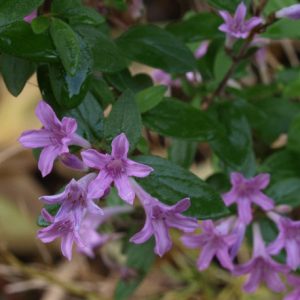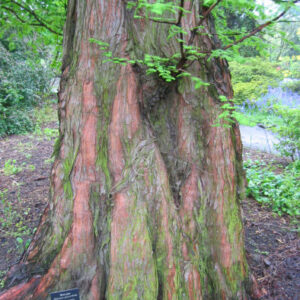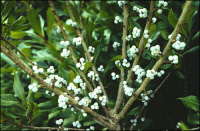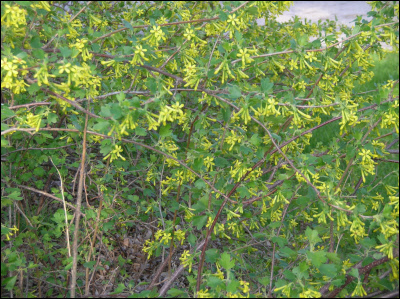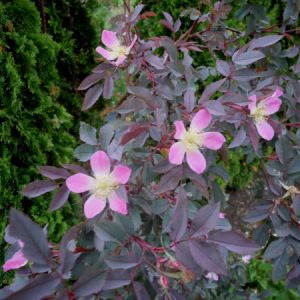Woody Ornamentals
Showing 33–40 of 46 results
-
Leptodermis oblonga Dwarf lilac Z 5-8
fragrant lavender, lilac-like trumpets blooming in June – October.
Low mounding shrub with fragrant lavender, lilac-like trumpets blooming in June – October. Leaves slow to leaf-out in spring but then blooms its heart out.
Size: 12-18” x 18-24” spreads by suckers
Care: sun to part shade in moist well-drained to well-drained soil
Native: No. & W. China & Himalayas.
Wildlife Value: Attracts hummingbirdsLeptodermis means “thin skin” and oblonga refers to the oblong leaves.
Introduced by E.H. Wilson in 1905. -
Liriodendron tulipfera Tulip tree Z 4-9
Large tulip-shaped yellow-green petals surround orange corolla, Ornamental leaves turn yellow in fall
Large tulip-shaped yellow-green petals surround orange corolla, Ornamental leaves turn yellow in fall
Size: 80-100’ x 30’
Care: sun in well drained to moist well drained soil. Fast growing and strong wood.
Native: New England to FL, Ontario to IL, south to Louisiana and all states in between.
Wildlife Value: attracts Tiger swallowtail butterfly.
Awards: Recipient Great Plant Pick Award from Elizabeth Carey Miller Botanical Garden & England’s Royal Horticultural Society Award of Merit & Great Plants for Great PlainsOne of the oldest flowering trees – about 95 million years old. Cherokee cured pinworms, cholera, dysentery, coughs, wounds, boils, fever, bone fractures, indigestion, snakebites, and “women with hysterics” with Tulip tree. Because it is light weight but strong they made canoes for up to 20 people with Tulip tree wood. The Rappahannock chewed the bark as a stimulant for sex. Sent to Europe by Tradescant before 1640. Grown by Jefferson. Washington planted them as an allée around the serpentine bowling green.
State tree of Indiana, Kentucky, North Carolina and Tennessee.
**LISTED AS OUT OF STOCK BECAUSE WE DO NOT SHIP THIS ITEM. IT IS AVAILABLE FOR PURCHASE AT OUR RETAIL LOCATION.
-
Metasequoia glyptostroboides Dawn redwood Z 4-8
Fast-growing, pyramidal-shaped deciduous conifer.
Fast-growing, pyramidal-shaped deciduous conifer. The orange to brown trunk base tapers and thickens with up to a dozen large buttress-like root flares extending several feet up the trunk. Feathery, fern-like, soft foliage emerges light green in spring, and turns red-bronze in fall before dropping. Its branches are well-attached and make excellent climbing.
Size: 70-90’ x 15-25’
Care: sun in moist to moist well-drained, slightly acid soil
Native: Szechuan China
Awards: Royal Botanic Garden Award of Garden Merit, Yew Dell Botanical Gardens’ Theodore Klein Plant Awards & Pennsylvania Horticultural Society GoldFrom fossil records, dawn redwood is known to have existed as many as 50,000,000 years ago. However, it was not until 1941 that dawn redwood was first discovered growing in the wild near the town of Modaoqi China by Chinese forester, T. Kan. Seeds collected from the original site were made available to the Missouri Botanical Garden in 1947. Seedlings grown therefrom were planted in front of the Lehmann Building at MBG in 1952 where they have now developed into large mature trees (70’+ tall). Dawn redwood is a deciduous, coniferous tree that grows in a conical shape to 100’ tall. It is related to and closely resembles bald cypress (Taxodium) and redwood (Sequoia).
-
Myrica pensylvanica syn. Morella pensylvanica Wax myrtle, Northern bayberry SHRUB Z 3-6
Green flowers in summer then, “conspicuous in winter when covered with its grayish white fruits which stay on the branches until spring.” Bailey “The leaves turn a fine brown-purple in the fall, but the berries are the thing – pewter in color, with a texture like those Fourth of July sparklers of childhood memory, they have a delicious fragrance.” Allen Lacy.
OUT OF STOCK
Green flowers in summer then, “conspicuous in winter when covered with its grayish white fruits which stay on the branches until spring.” Bailey “The leaves turn a fine brown-purple in the fall, but the berries are the thing – pewter in color, with a texture like those Fourth of July sparklers of childhood memory, they have a delicious fragrance.” Allen Lacy.
Size: 9’ x 10’
Care: sun in any soil
Native: Canada to Southeastern U.S. No pruning needed but can be pruned at any time of year, if desired.
Wildlife Value: Berries relished by chickadees, red-bellied woodpeckers, swallows, Titmouse, catbirds, bluebirds, Northern flicker & yellow-rumped warblers. Bayberry thickets also provide nesting sites for songbirds, offering excellent protection from predators.Probably 1st collected for gardens by John Bartram (1699-1776). Offered for sale in Bartram Garden’s 1783 Broadside, America’s 1st plant catalog. In 1800’s considered “very ornamental in the shrubbery.” Fragrant leaves used for potpourri, abundant berries used to make candles. Good road-side plant, salt tolerant. Berries used to make candles. Boil berries (drupes) to melt wax coating. Collect wax from surface of water. In American Medicinal Plants Charles F. Millspaugh noted that “Candles made from this wax, though quite brittle, are less greasy in warm weather, of fine appearance, slightly aromatic, and smokeless after snuffing, rendering them much more pleasant to use than those made of either wax (paraffin) or tallow (animal fat).” 1892.
-
Philadelphus lewisii Lewis’ Mock Orange Z 4-9
A triple delight. From late spring to early summer clusters of 2” wide, four-petaled, snow-white flowers with a center boss of sunny stamens smother stem ends on this vase-shaped shrub. The flowers perfume the air with a delicious, orange scent. Then in fall the foliage turns citrus-yellow. Idaho adopted this as the state flower.
A triple delight. From late spring to early summer clusters of 2” wide, four-petaled, snow-white flowers with a center boss of sunny stamens smother stem ends on this vase-shaped shrub. The flowers perfume the air with a delicious, orange scent. Then in fall the foliage turns citrus-yellow. Idaho adopted this as the state flower.
Size: 5-10’ x 5-7’
Care: sun to part-shade in moist to well-drained soil
Native: from British Columbia to California, east to Montana.
Wildlife Value: Nectar and pollen attract bumble bees, moths, butterflies and hoverflies. It hosts caterpillars and chrysalises. Many birds eat the seeds.Natives used its strong and hard wood to make arrows, bows, combs, pipes for smoking, snowshoes, clubs, armor to protect chests, fishing spears, harpoon shafts, sticks for digging, knitting needles and baskets. Meriwether Lewis collected this plant on the Lewis & Clark Expedition in two places, in early May 1806 in Nez Perce County Idaho and two months later in Missoula County, Montana.
-
Philadelphus microphyllus syn. Philadelphus occidentalis Littleleaf mockorange, Western Mock Orange Z 4-9
Four swan-white, undulating-edged petals on each flower circle around canary-colored stamens in early summer. Its flowers give off a strong fragrance of oranges with a hint of pineapple blooming from its multi-branch ends of these variable shrubs with yellow foliage in fall.
Four swan-white, undulating-edged petals on each flower circle around canary-colored stamens in early summer. Its flowers give off a strong fragrance of oranges with a hint of pineapple blooming from its multi-branch ends of these variable shrubs with yellow foliage in fall.
Size: 3-8’x 3-5’ big variations in size
Care: Sun in well-drained soil, drought tolerant
Native: West and southwest: CA, AZ, CO, NM, TX & UTIsleta Pueblo Indians ate the berries. Sanders, The Flower Garden (1913): “Forms a dense bush, 3 ft. high …flowers in summer, a pretty kind. A native of Colorado.”
**LISTED AS OUT OF STOCK BECAUSE WE DO NOT SHIP THIS ITEM. IT IS AVAILABLE FOR PURCHASE AT OUR RETAIL LOCATION.
-
Ribes aureum syn. Ribes odoratum Clove currant Z 3-8
Early to mid-spring yellow flowers shaped like a tube with 5 petals opening wide at the ends smother the shrub giving off a sweet, clove-scented fragrance – heavenly. Ships only in spring.
Early to mid-spring yellow flowers shaped like a tube with 5 petals opening wide at the ends smother the shrub giving off a sweet, clove-scented fragrance – heavenly. Ships only in spring.
Size: 6' x 6' spreading
Care: Sun in moist well-drained to well-drained soil.
Native: west-central US
Wildlife Value: Attracts bees, butterflies and hummingbirds for nectar. Small mammals eat the berries. Immune to Walnut toxinsMany tribes ate the berries. Shoshone and Paiute used the shrub’s inner bark to heal sores and swellings. Meriwether Lewis on the Lewis & Clark Expedition found this in 2 locations – “near the narrows of the Columbia” April 16 1806, now Klickitat County Washington, and on July 29, 1805 in Montana.
**LISTED AS OUT OF STOCK BECAUSE WE DO NOT SHIP THIS ITEM. IT IS AVAILABLE FOR PURCHASE AT OUR RETAIL LOCATION.
-
Rosa rubrifolia syn. Rosa glauca Z 3-9
Medium pink single blooms in spring. Purplish foliage bearing red-purple hips in autumn.
EMAIL FOR AVAILABILITY
Medium pink single blooms in spring. Purplish foliage bearing red-purple hips in autumn.
Size: 7’ x 5’
Care: Full sun to part shade in moist well-drained soil. Disease resistant. Japanese beetles seem not to be interested in this rose.
Native: Central Europe
Awards: Plant Select; Elisabeth Carey Miller Botanical Garden Great Plant Pick & Great Plants for Great Plains; Royal Botanical Society Award of Garden MeritIn garden cultivation since 1830
**LISTED AS OUT OF STOCK BECAUSE WE DO NOT SHIP THIS ITEM. IT IS AVAILABLE FOR PURCHASE AT OUR RETAIL LOCATION.

